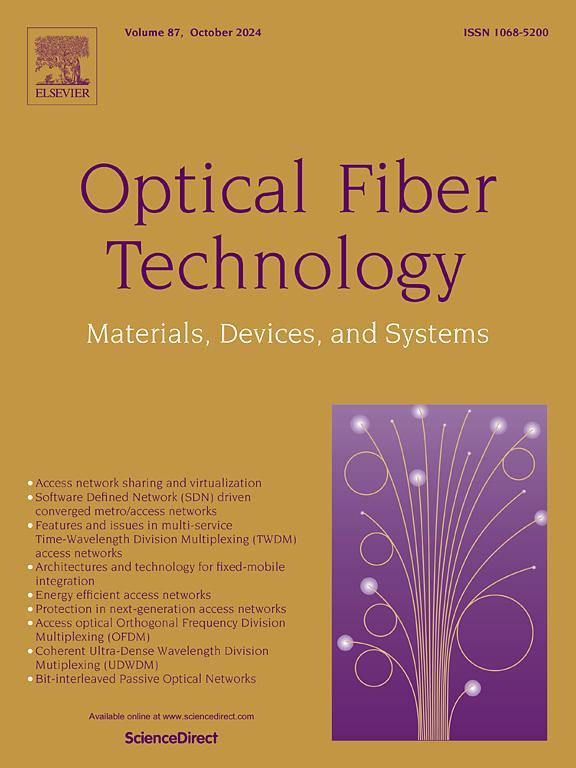Airborne particle trapping via counter-propagating laser beams for ultrasensitive acoustic sensing
IF 2.7
3区 计算机科学
Q2 ENGINEERING, ELECTRICAL & ELECTRONIC
引用次数: 0
Abstract
Conventional electroacoustic sensors face critical limitations in extreme electromagnetic interference (EMI) scenarios such as ultra-high-voltage transmission and particle accelerators, manifesting as sensitivity constraints (SNR < 40 dB for MEMS microphones) and mechanical coupling failures. This study presents a counter-propagating dual-beam fiber-optic acoustic sensing architecture, where two precisely aligned single-mode fiber cores establish an interference field. A nebulizer delivers microparticles to the beam overlap zone, enabling stable optical-axis confinement to form a miniaturized Fabry-Perot resonant cavity. External acoustic perturbations induce particle displacement, which is transduced into optical phase modulation for contactless sensing. Experimental results demonstrate a operational bandwidth spanning 10 Hz–12 kHz with near-unity linearity (R2 = 0.991) and maximum SNR of 57 dB @500 Hz, representing a 17 dB enhancement over conventional piezoelectric counterparts. The system also has high sensitivity, a sensitivity of 334.9 mV/Pa at 500 Hz, and a noise-equivalent pressure of 91.7 μPa/√Hz@500 Hz. Rigorous repeatability testing confirms tightly controlled SNR amplitude fluctuations, validating system stability. The compact geometry, inherent EMI immunity, and broadband detection capabilities position this device as a transformative solution for nonlinear single-particle acoustics and industrial monitoring under conditions.
利用反传播激光束进行超灵敏声波传感的空气粒子捕获
传统的电声传感器在极端电磁干扰(EMI)场景下(如超高压传输和粒子加速器)面临着严重的局限性,表现为灵敏度限制(MEMS麦克风的信噪比为40 dB)和机械耦合故障。本研究提出了一种反向传播的双光束光纤声传感结构,其中两个精确排列的单模光纤芯建立了干涉场。雾化器将微粒输送到光束重叠区,实现稳定的光轴约束,形成小型化的法布里-珀罗谐振腔。外声扰动诱导粒子位移,将其转化为光学相位调制用于非接触式传感。实验结果表明,工作带宽跨越10 Hz - 12 kHz,线性度接近统一(R2 = 0.991),最大信噪比为57 dB @500 Hz,比传统压电器件提高了17 dB。该系统灵敏度高,500 Hz时灵敏度为334.9 mV/Pa,噪声等效压力为91.7 μPa/√Hz@500 Hz。严格的重复性测试确认了严格控制的信噪比幅度波动,验证了系统的稳定性。紧凑的几何结构、固有的EMI抗扰度和宽带检测能力使该器件成为非线性单粒子声学和工业监测条件下的变革性解决方案。
本文章由计算机程序翻译,如有差异,请以英文原文为准。
求助全文
约1分钟内获得全文
求助全文
来源期刊

Optical Fiber Technology
工程技术-电信学
CiteScore
4.80
自引率
11.10%
发文量
327
审稿时长
63 days
期刊介绍:
Innovations in optical fiber technology are revolutionizing world communications. Newly developed fiber amplifiers allow for direct transmission of high-speed signals over transcontinental distances without the need for electronic regeneration. Optical fibers find new applications in data processing. The impact of fiber materials, devices, and systems on communications in the coming decades will create an abundance of primary literature and the need for up-to-date reviews.
Optical Fiber Technology: Materials, Devices, and Systems is a new cutting-edge journal designed to fill a need in this rapidly evolving field for speedy publication of regular length papers. Both theoretical and experimental papers on fiber materials, devices, and system performance evaluation and measurements are eligible, with emphasis on practical applications.
 求助内容:
求助内容: 应助结果提醒方式:
应助结果提醒方式:


